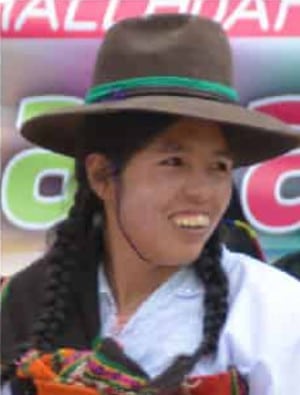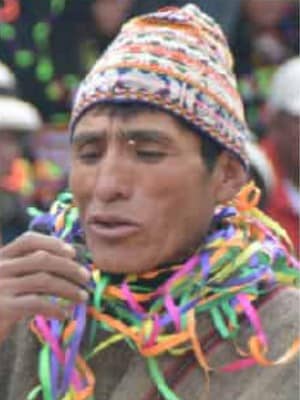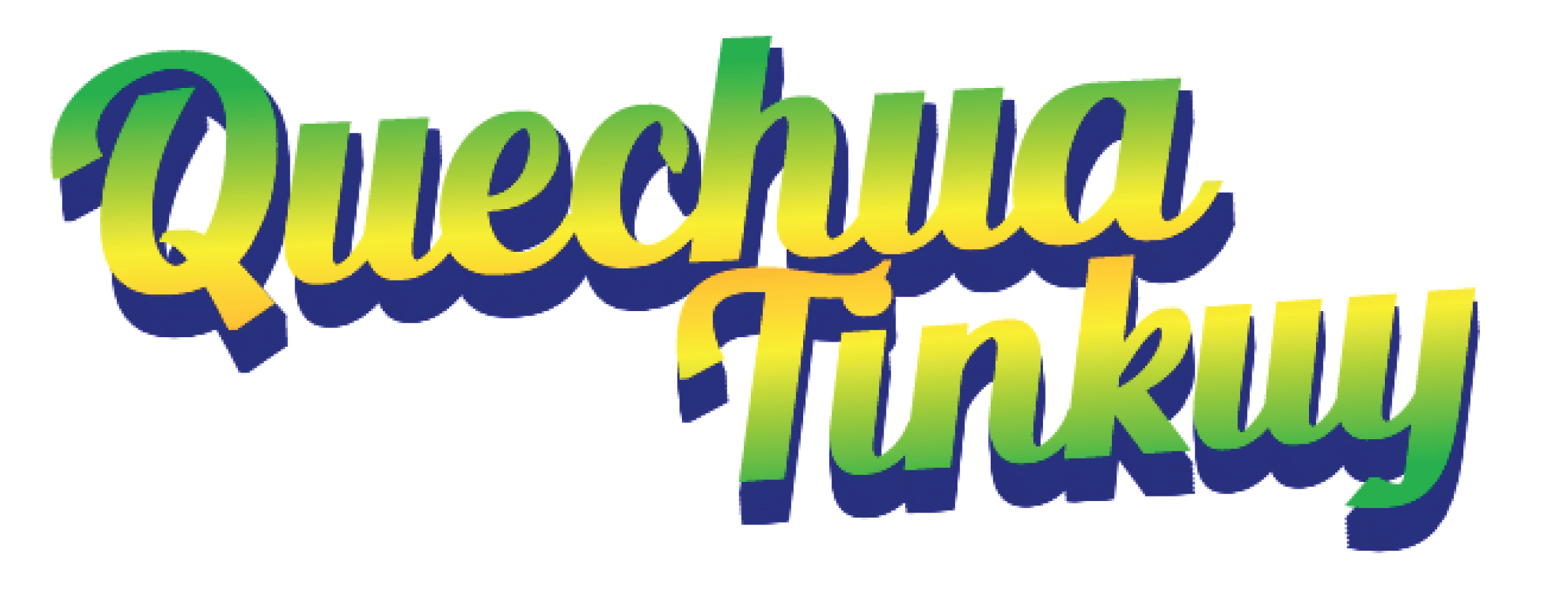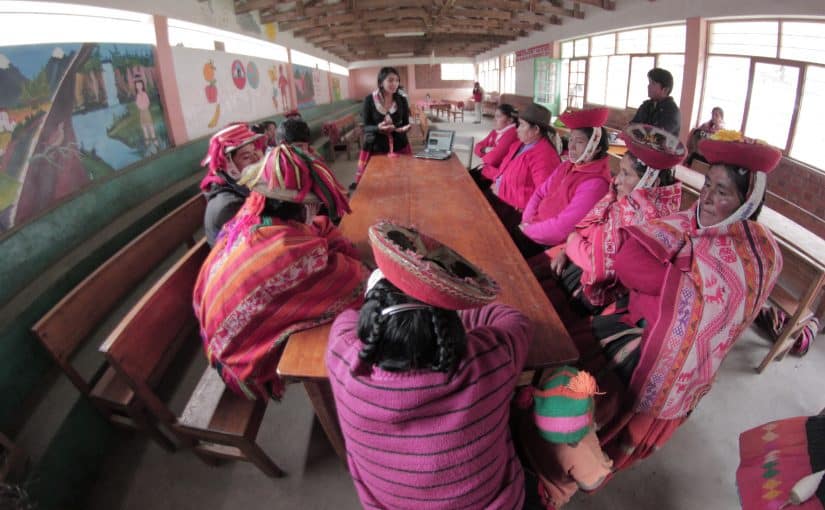
Qallarinapaq | Introduction
In this unit you will learn how to introduce yourself to others and create and respond to basic questions in a conversation. For this, we will continue to work with the personal pronouns, in this case the simple present of the first person ñuqa/ñoqa, the verb with the corresponding person markerni, and second person marker qan/qam, the verb with the corresponding person markernki.
Note: For a better understanding and explanation we are using the dash (-) as a separator of the word and the suffix, for example:
Ñoqa Maria ka-ni (In this case the suffix ni marks the action that corresponds to the first person).
Qan Valentin kanki (in this case the suffix nki marks the action that corresponds to the second person).
The sentence I am Maria is structured in the following way:
| I | Maria | kani |
| (I) | (Maria) | (am) |
| 1st Person | Subject | Verb |
The sentence I live in Texas is structured in the following way:
| I | Texaspi | tiyani |
| (I) | (in Texas) | (live) |
| 1st Person | Indicates place | Verb |
The sentence You are Maria is structured in the following way:
| You | Maria | kanki |
| (You) | (Maria) | (are) |
| 2nd Person | Subject | Verb |
The sentence You live in Texas is structured in the following way:
| You | Texaspi | tiyanki |
| (You) | (in Texas) | (live) |
| 1st Person | Indicates place | Verb |
Note: Remember that the locative pi refers to place, next, some examples:
| Lima-pi | In Lima |
| Limapi tiya-ni | I live in Lima |
| Limapi tiya-nki | You live in Lima |
| Qosqo-pi | In Cusco |
| Qosqopi tiya-ni | I live in Cusco |
| Qosqopi tiya-nki | You live in Cusco |
| California-pi | In California |
| Californiapi-ni | In California |
| California tiya-nki | You live in Lima |
In this section we will also learn the assertive markers n (in words that end in a vowel), taq (in questions) and mi (in words that end in a consonant) that are used to put emphasis on an expression, and the accusative marker ta that is used for the direct object.
For questions that begin with "Ima" which means "what" the emphasis or interest in the question is given in the following way:
| Ima | little emphasis |
| Iman | more emphasis |
| Imataq | most emphasis |
Ready? ¡Qallarisun! Let's get started!

Qillqa | Grammar
In a conversation where we introduce ourselves to someone, generally we include information about our name, origin, profession, and others. In some conversations we also describe our daily activities. For this we have the following interrogative words:
| ¿Ima? | What? |
| ¿Imayna? | How? |
| ¿May? | Where? |
| ¿Hayk’aq? | When? |
Examples:
| ¿Ima sutiyki? | What is your name? |
| ¿Imayna llaqtayki? | What is your town like? |
| ¿Maymanta kanki? | Where are you from? |
| ¿Hayk’aq hamunki? | When do you sell? |
| Ima sitiyki | What is your name? | (little emphasis) |
| Iman sutiyki | What is your name? | (more emphasis) |
| Imataq sutiyki | What is your name? | (most emphasis) |
| ¿Imayna llaqtayki? | What is your town like? | (little emphasis) |
| ¿Imayna-n llaqtayki? | What is your town like? | (more emphasis) |
| ¿Imayna-taq llaqtayki? | What is your town like? | (most emphasis) |
| ¿Maymanta kanki? | Where are you from? | (little emphasis) |
| ¿Maymanta-n kanki? | Where are you from? | (more emphasis) |
| ¿Maymanta-taq kanki? | Where are you from? | (most emphasis) |
| ¿Hayk’aq hamunki? | When do you sell? | (little emphasis) |
| ¿Hayk’aq-mi hamunki? | When do you sell? | (more emphasis) |
| ¿Hayk’aq-taq hamunki? | When do you sell? | (most emphasis) |
If we want to use the most emphasis in questions or responses, we should use the assertive markers taq, n, mi, next, we will describe the use of each.
TAQ: Is a euphonic particle of courtesy or to show interest (it is generally used when a person is very interested in something).
Example:
To put emphasis on the questionIma sutiyki? What is your name? we should add the particle taq to the interrogative word Ima.
Imataq sutiyki (taq puts more emphasis in knowing what the person's name is).
N, MI: Are assertive euphonic markers that are used in responses to questions. These responses show interest, conviction to mention something.
Example:
Before in the question ¿Ima-n sutiyki? emphasis is placed on the response in the following way:
Sutiy Jorge My name is Jorge
To put more emphasis we should add the marker mi.
Sutiymi Jorge (mi puts more emphasis on the response).
TA: Is an accusative marker that works with direct objects and is used with transitive verbs.
Example:
For the action of Wallpa wayk’uni I cook chicken we should add the marker ta.
Ñuqa wallpata wayk’uni (ta signals the direct object, in this case the action of cooking chicken).
Qan wallpa-ta wayk’unki
Ñuqa papa-ta allani
Qan papa-ta allanki
Let's look at the following dialogues between Julia and Carlos:


With little emphasis
Julia: Turay Carlos ¿Ima-ta ruwa-nki?
Carlos: Panay Julia, wasiypi wayk’uni ¿Qanri?
Julia: Ñuqa wasi-y-pi tusuni
Carlos: Kusa panay Julia. Tupananchis-kama
Julia: Tupananchis-kama turay Carlos
Carlos: Tupananchis-kama panay Julia.
Dialogue with more emphasis
Julia: Turay Carlos ¿Ima-ta-n ruwa-nki?
Carlos: Panay Julia, wasiypi-n wayk’uni ¿Qanri?
Julia: Ñuqa wasi-y-pi-n tusuni
Carlos: Kusa panay Julia. Tupananchis-kama
Julia: Tupananchis-kama turay Carlos
Carlos: Tupananchis-kama panay Julia.
Dialogue with the most emphasis
Julia: Turay Carlos ¿Ima-ta-taq ruwa-nki?
Carlos: Panay Julia, wasiypi-n wayk’uni ¿Qanri?
Julia: Ñuqa wasi-y-pi-n tusuni
Carlos: Kusa panay Julia. Tupananchis-kama
Julia: Tupananchis-kama turay Carlos
Carlos: Tupananchis-kama panay Julia.
Now we will look at the use of assertive markers in the following dialogue that uses the direct object to see the range of emphasis.
Little emphasis
¿Ima-ta ruwanki Julia? ¿What are you doing, Julia?
Wasi-y-ta-n picha-ni I sweep my house
More emphasis
¿Ima-ta-n ruwa-nki Julia? ¿What are you doing, Julia?
Wasi-y-ta-n picha-ni I sweep my house
Most emphasis
¿Ima-ta-taq ruwa-nki Julia? ¿What are you doing, Julia?
Chakra-y-pi sara-ta tarpu-ni ˆI sow corn in the field
Nota. On the word sara-ta, the marker ta refers to the direct object after the transitive verb tarpuy.
¿Imayna? What is your house like?
¿Imayna wasiyki What is your house like?
Imayna-n wasiyki What is your house like?
Imaynataq wasiyki What is your house like?

Rimanakuna | Vocabulary
In this unit you will find a list of transitive (requires a complement) and intransitive (does not require a complement) verbs that you will also use throughout the rest of the units.
Transitives
| Yachachiy | to teach |
| Yuyariy | to remember |
| Qhaway | to watch / to look |
| Rikuy | to see |
| Napaykuy | to greet |
| Maqcchiy | to wash |
| Mikhuy | to eat |
| Wayk’uy | to cook / to prepare |
| Hanpiy | to cure / to heal |
| Pichay | to sweep |
| Munay | to want / to desire |
| Maskhay | to look for / to search |
| Tariy | to find |
| Saqey | to leave |
| Hoqariy | to get up |
| Horqoy | to take out |
| Saruy | to walk on / to step on |
| Churay | to put |
| Phukuy | to blow |
| Apay | to bring |
| Apamuy | to bring |
| Watay | to tie |
| Paskay | to tie |
| Qhellichay | to get dirty |
| Malliy | to try |
| Chaskiy | to receive |
| Qoy | to give |
| Qelqay | to write |
| Yanapay | to help |
| Qonqay | to forget |
| Ñawinchay | to read |
| Rimay | to speak |
| Rakiy | to distribute |
| Suyay | to wait |
Intransitives
| Puñuy | to sleep |
| Takiy | to sing |
| Tusuy | to dance |
| Puriy | to walk |
| Phaway | to leave |
| Samay | to rest |
| Waqay | to cry |
| Rimay | to speak |
| Tiyay | to live / to reside |
| Llank’ay | to work |
| Wiñay | to grow |
| Riy | to go |
| Qapariy | to yell |
| Sayariy | to stand |
| Sayk’uy | to get tired |
| Pisipay | to get tired |
| Chayay | to arrive |
| Kutiy | to return |
| Kutimuy | to return |
| Hamuy | to come |
| Niy | to say (opinion) |
| Willay | to inform |
| Uyariy | to listen |
| Uyakuy, kasukuy | to obey |
| Tapuy | to ask |
| Waqyay | to call |
| Yupay | to count |
| Reqsiy | to know |
| Yachay | to learn |

Ruwapakuy | Exercises
In your notebook, write some sentences using Ima What? and May Where? with each of the emphasis levels (n, taq), for this use the following information as a reference:
| ¿Ima? | What? | What (with little emphasis) |
| ¿Ima-n? | What? | What (with more emphasis) |
| ¿Ima-taq? | What? | What (with most emphasis) |
| ¿May? | Where? | Where (with little emphasis) |
| ¿May-pi? | Where? | Where (with little emphasis) |
| ¿May-pi-n? | Where? | Where (with more emphasis) |
| ¿May-pi-taq? | Where? | Where (with most emphasis) |
In sentences that require a transitive verb , conjugate a verb from the vocabulary section of this unit using the direct object marker ta
| ¿Ima-ta ruwanki? | What do you do? | What do you do (with little emphasis) |
| ¿Ima-ta-n? | What do you do? | What do you do (with more emphasis) |
| ¿Ima-ta-taq? | What do you do? | What do you do (with most emphasis) |
Use responses such as:
- Papa-ta wayk’u-ni
- Futbol-ta puklla-ni
- Sara-ta mikhu-ni

